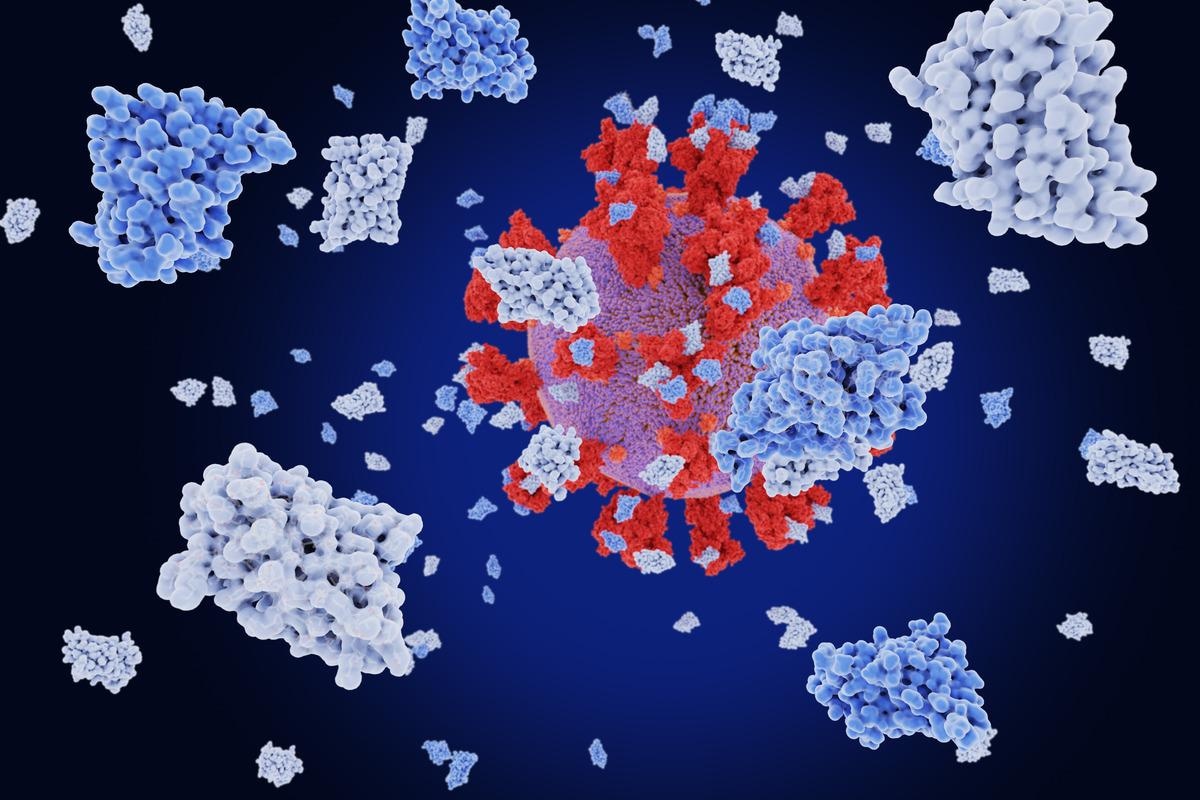In a recent study posted to the bioRxiv* preprint server, researchers developed covalent nanobodies (single-domain antibodies) to neutralize severe acute respiratory syndrome coronavirus-2 (SARS-CoV-2) and its variants.

The ongoing coronavirus disease 2019 (COVID-19) pandemic and the emergence of new SARS-CoV-2 variants throughout the pandemic warrants effective prophylactic drugs and treatment. Besides vaccines against SARS-CoV-2, the development of drugs and therapies inhibiting the virus is essential. Some drugs inhibiting the interactions between the SARS-CoV-2 spike (S) protein and the host receptor, angiotensin-converting enzyme 2 (ACE2), have been developed. Yet, it remains challenging to inhibit or block SARS-CoV-2 infection completely. Some protein-based biologics have been developed, which exert their effects through non-covalent interactions. Since these interactions are reversible, the virus can reinfect cells once the (protein biologic) drug dissociates.
Naturally available proteins, in general, do not bind to their targets covalently. To overcome this limitation, researchers of the study had previously demonstrated proximity-enabled reactive therapeutics (PERx) strategy to create covalent protein drugs. In this method, an unnatural amino acid (Uaa) is introduced in the protein biologic drug, which only reacts with natural target residue when the drug and target interact, establishing a covalent crosslink.
The study and findings
In the current study, researchers developed protein nanobodies exhibiting covalent interactions and irreversible binding to inhibit SARS-CoV-2 and variants. They employed the PERx principle to create covalent nanobodies and initially introduced fluorosulfate-L-tyrosine (FSY) as the Uaa because it is stable and reacts with tyrosine, histidine, and lysine residues under biocompatible cellular conditions through proximity-enabled sulfur fluoride exchange (SuFEx) reaction.
FSY was genetically encoded into H11-D4, MR17-K99Y, and SR4 nanobodies at different sites. In vitro examination confirmed that wild-type (WT) nanobodies failed to bind to the S protein covalently, whereas the mutant nanobodies formed covalent crosslinks with S-RBD. The crosslinking efficiency was low for H11-D4 nanobody, 10.5% for MR17-K99Y (101FSY), 28.3% for SR4 (54FSY), and 41.3% for SR4 (57FSY). Time-dependent analyses noted SR4 (57FSY) as efficient and were used for subsequent studies.
Next, the efficacy of SR4 nanobodies in inhibiting the binding of S-RBD to ACE2 receptors was determined. Not surprisingly, the WT SR4 demonstrated reversible inhibition of S-RBD binding to ACE2 receptor, while the covalent SR4 (57FSY) showed efficient binding to the S-RBD, inhibiting RBD and ACE2 binding. Covalent SR4 exhibited significant potency in inhibiting SARS-CoV-2 pseudovirus than WT SR4, but with a moderate enhancement over WT SR4.
A similar experiment was recapitulated with authentic SARS-CoV-2 virus, and surprisingly, there was no significant enhancement in the inhibition of covalent SR4 over WT SR4. Crystal structure analysis revealed that SR4 accesses and binds with S-RBD in its active ‘up’ state.
Instead, the authors reasoned that binding in the inactive ‘down’ state of S-RBD might be effective. To this end, they engineered mNb6 nanobody with FSY as mNb6 binds to S-RBD in the ‘down’ state. FSY was individually incorporated at 30 sites in mNb6 at three complementarity-determining regions (CDRs). Covalent crosslinking of mNb6 with S-RBD was observed for multiple locations in mNb6, and they noted that the mNb6 (108FSY) site had the fastest crosslinking rate.
A fluorine-substituted FSY (FFY) was introduced as the Uaa in mNb6 at the 108 locus, speculating that an electron-withdrawing substituent of FSY could accelerate the PERx reaction rate. Expectedly, a 2.4-fold increase in the PERx reaction rate was observed for mNb6 (108FFY) nanobody over the mNb6 (108FSY) system. With mNb6 (108FFY) system, the potency and efficacy of RBD:ACE2 inhibition was improved in both pseudovirus and authentic SARS-CoV-2 experiments.
Moreover, the mNb6 (108FFY) potently inhibits pseudoviruses of Alpha and Delta variants. Lastly, the research team engineered the soluble ACE2 receptor as a covalent binder for S protein. ACE2 was incorporated individually at multiple sites, and it was noted that ACE2 (34FSY) had the highest crosslinking efficiency (28.3%) and there was covalent crosslinking between S-RBD and ACE2 (34FSY).
Conclusions
The current study showed the effective inhibitory potential of genetically engineered covalent nanobodies on the binding of the S-RBD and the human ACE2 receptor through the PERx strategy. Furthermore, FFY incorporation increased the reaction rate by 2.4-fold, and the resultant nanobody [mNb6 (108FFY)] inhibited both authentic SARS-CoV-2 and the pseudovirus.
Interestingly, engineering a soluble ACE2 receptor with FSY as a covalent binder demonstrated irreversible crosslinking. These findings showed that protein nanobodies could be readily synthesized as covalent binders and that the PERx principle could be extrapolated for engineering covalent protein drugs for other infectious diseases.
*Important notice
bioRxiv publishes preliminary scientific reports that are not peer-reviewed and, therefore, should not be regarded as conclusive, guide clinical practice/health-related behavior, or treated as established information.
- Bingchen Yu, Shanshan Li, Takako Tabata, Nanxi Wang, G. Renuka Kumar, Jun Liu, Melanie M. Ott, Lei Wang. (2022). Accelerating PERx Reaction Enables Covalent Nanobodies for Potent Neutralization of SARS-Cov-2 and Variants. bioRxiv. doi: https://doi.org/10.1101/2022.03.11.483867 https://www.biorxiv.org/content/10.1101/2022.03.11.483867v1
Posted in: Medical Research News | Disease/Infection News | Healthcare News
Tags: ACE2, Amino Acid, Angiotensin, Angiotensin-Converting Enzyme 2, Antibodies, Coronavirus, Coronavirus Disease COVID-19, covid-19, Drugs, Efficacy, Electron, Enzyme, Fluoride, Fluorine, Histidine, in vitro, Infectious Diseases, Locus, Lysine, Nanobodies, Pandemic, Protein, Pseudovirus, Receptor, Research, Respiratory, SARS, SARS-CoV-2, Severe Acute Respiratory, Severe Acute Respiratory Syndrome, Sulfur, Syndrome, Therapeutics, Tyrosine, Virus

Written by
Tarun Sai Lomte
Tarun is a writer based in Hyderabad, India. He has a Master’s degree in Biotechnology from the University of Hyderabad and is enthusiastic about scientific research. He enjoys reading research papers and literature reviews and is passionate about writing.
Source: Read Full Article